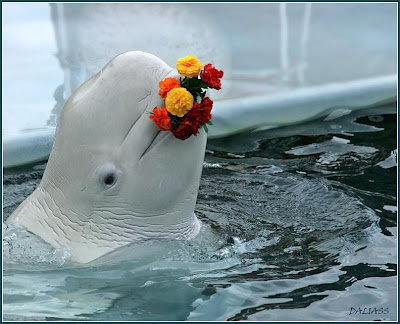The History and Evolution of Dogs
The Evolution of Dogs - Is Man's best friend really a descendent of tamed wolves? - The Facts!
Biologists have debated over the history and evolution of the domestic dog for hundreds of years. Most Scientists now agree that dogs are directly descended from Canis Lupus - the Grey Wolf. Dr. Robert K. Wayne, canid biologist and molecular geneticist at UCLA, has shown, through DNA research, that dogs are more closely related to the Grey Wolf than Biologists had previously suspected. In fact, due in large part to Dr. Robert K. Wayne's genetic research, the authors of the "Mammal Species of the World" the internationally accepted reference source on mammal species, reclassified the dog in 1993 from Canis Familiaris to Canis Lupus.
The Evolution Dogs from Wolves - How could Wolves be tamed and Why?
We will never now exactly why or how wolves were tamed by man, but remains of dogs dating back 10 to 15 thousand years have been found, so we at least have a "ball-park" figure of when which helps to build a picture of the History and Evolution of dogs. The wolf and man had several important things in common, we were both hunters and also hunted in packs. It is certain that during our history our paths would have regularly crossed, we would have even hunted and eaten each other! The most likely scenario is that a human hunting party came across a very young Wolf Cub and decided to take it with them. The Wolf Cub would have been very puppy like at an early age, when grown although far less trustworthy than a dog of today, would not have been quite as dangerous as a wild Wolf. A semi-tamed Wolf would probably have had considerable value to a hunter gatherer group, lending its superior hunting senses to the group. This would have helped not just in hunting but defensively as a warning system as well. The evolution of the wolf to the domestic dog began.
The Evolution of the Domestic Dog - Selective Breeding Process
Puppy rescue would not have been an isolated case but would have happened in many different groups of human hunters over our thousands of years of evolution and history. Selective breeding would have been automatic. Keeping a wolf that became overly aggressive towards the humans, or of little practical use, would have been both pointless and dangerous - such a wolf would have been killed. Only the remaining Wolves, with desirable traits, would have been selected to breed. Eventually the traits of each group of tame Wolves would reflect the needs of the group of humans it lived with: it's size, colouring, senses and even the length of its coat or swimming ability reflecting the needs of the hunters and their environments. Eventually as the number of humans increased some degree of trade would have occurred between groups, puppies being swapped and traded based on the inbred traits they now possessed - the evolution and history of various dog breeds are explained.
The Evolution of Dogs from Wolves - Descendent of the Domestic Dog
Dr. Robert K. Wayne's work implies that the modern dog, although very similar genetically to the Grey
Wolf, has many separately distinct origins in both time and locations. The Grey Wolf and our modern "canine best friend" are in fact so closely related to Grey Wolves that they can still interbreed, producing fully viable offspring.
How did dogs impact Human History? - The Evolution of the Different Breeds of Dogs
Understanding the changing requirements of man through our history and evolution enables us to put into perspective the hundreds of different breeds which were developed by man. The Groups, Classifications and Standards all begin to make perfect sense. The various 'landmarks' of the history and evolution of dogs is detailed below - for more details of each particular type of dog please refer to the links at the top of the page.
The Evolution & History of Dogs - The Sight Hounds
Sighthounds , also known as Gazehounds as their gaze focuses on the horizon seeking game, specialise in hunting their quarry by sight rather than scent. Sighthounds have distinctive characteristics, features and traits which are perfect for their purpose. Sighthounds have extremely good vision. They also have a long jaw and lengthy neck which assists them in sighting their quarry. Their lean muscular body, deep chest and long powerful legs essential assets when following any fast and agile prey.
Dogs History - The Scent Hounds
Scent Hounds specialise in following the scent or the smell of its quarry. It was not necessary for Scent Hounds to be as fast and agile as Sighthounds - they do not need to keep their quarry in sight. Scent hounds are built for endurance. They can follow a scent for long distances and even across running water. Scent Hounds have distinctive characteristics, features and traits which are perfect for their purpose. They have large noses which have deep, open nostrils and their lips are loose and moist, designed to pick up scent particles and follow the trail of an animal. Their ears are long which concentrates the scent on the nose. Their bodies are designed for endurance, an essential asset when following any scent trail.
Dogs Evolution & History - The Hound Dog Breeds
Hound Dogs have been bred to chase (or hound) a quarry by sight or smell, or a combination of both senses. Sighthounds have exceptional eyesight, combined with the speed and stamina necessary to catch the intended prey once seen, typical examples being the Greyhound and the Whippet. Hounds which rely strongly on the sense of smell to follow the trail of a prey, such as the Bloodhound, quite literally follow their noses, speed and eyesight is of less importance.
The Evolution & History of Dogs - Working Dog Breeds
Dogs in the Working group, were developed to perform a wide variety of tasks, such as herding, droving, pulling, hauling, herding, hunting, rescuing and guarding. The very nature of many of these tasks require a big, strong dog. Working dogs have always been viewed as real assets to their owners and have worked with man replacing larger animals such as horses when none such animals were available.
Dogs Evolution and History - Sporting Dog Breeds - Retrievers, Pointers and Setters
Sporting Dogs hunt by air scent, as opposed to ground scent. The Retriever, Pointer and Setter dogs were bred selectively which resulted in them fulfilling the needs of man. Retriever dogs find and return killed game to the hunter. Some Retrievers are especially equipped, for instance with a water-repellent coat and webbed feet, for retrieving downed waterfowl. Pointer dogs stand in front of their quarry, with their nose and body rigidly still , thus directing (or pointing) the hunter to its location. Setter dogs were originally trained to set, or crouch, in front of game preventing the escape of the quarry. The hunter would make the capture with a net. Man's own evolution and development in technology moved the traditional hunting methods away from primitive tools and nets - the Sporting Dogs were then called the Gundogs.
Dogs History and Evolution - The Terrier Dog Breeds
Dogs in the Terrier group were developed to hunt and kill vermin. The vermin included control rats, mice and other predatory animals such as foxes that might raided a farmer's produce and livestock. The very nature of these tasks required an energetic, tenacious, brave and determined dog.
The History of Dogs - The Non-Sporting Breeds
The characteristics and features of Non-Sporting Dogs cannot be generalised. Each breed would have originally have been introduced and strengthened by breeding with animals who already demonstrated the desired traits. As times, fashions and societies changed man established the need for breeds to assist in what was once considered entertainment such as bull or bear baiting or performing in a circus.
The Evolution & History of Dogs - Toy Dog Breeds
The Toy dogs were initially owned by the wealthy and were viewed by others as status symbols - a luxury item with little apparent purpose. The trend continue to this day. The references to Toy and miniature dogs are slowly being exchanged with references to Teacup dogs - a cute and descriptive name which is ideal for marketing this diminutive type of dog.
The History & Evolution of Dogs - Dog Shows
Man's passion and pride in his dog led to the desire to show his dog and compare it to other breeds. The organised dog shows were therefore born in the middle of the 19th Century. The dogs were unidentified except for their kennel names! This led to real confusion - there were quantities of dogs with the same names - Rover, Spot etc which were insufficiently described according to their breed or type. Organisation was required - descriptions and breed standards were needed - the Kennel Clubs were born!
The Evolution & History of Dogs - The Modern Domestic Dog
The history and evolution of the various dog breeds still continues today. New uses are being found. The technology and the innovation of the Space Age led to the Russian Space dogs (please refer to the category and link at the top of the page on Famous dogs for more details) Dogs have even become Movie Stars. What will be the next step in the History and Evolution of Dogs?












































